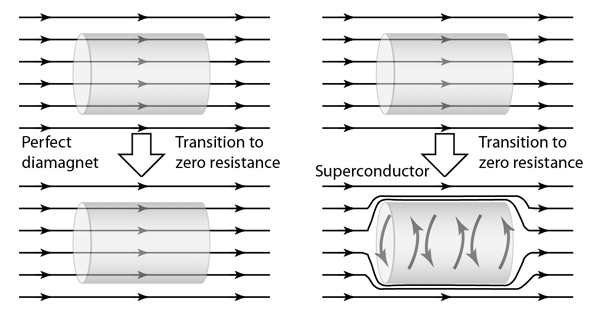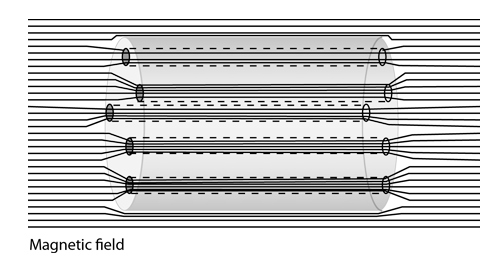The Meissner Effect
| | |
 | |
| Magnetic levitation | Further discussion |
Superconductivity concepts
Reference Rohlf,Ch 15
| HyperPhysics***** Condensed Matter | R Nave |
The Meissner EffectWhen a material makes the transition from the normal to superconducting state, it actively excludes magnetic fields from its interior; this is called the Meissner effect. This constraint to zero magnetic field inside a superconductor is distinct from the perfect diamagnetism which would arise from its zero electrical resistance. Zero resistance would imply that if you tried to magnetize a superconductor, current loops would be generated to exactly cancel the imposed field (Lenz's law). But if the material already had a steady magnetic field through it when it was cooled trough the superconducting transition, the magnetic field would be expected to remain. If there were no change in the applied magnetic field, there would be no generated voltage (Faraday's law) to drive currents, even in a perfect conductor. Hence the active exclusion of magnetic field must be considered to be an effect distinct from just zero resistance. A mixed state Meissner effect occurs with Type II materials. One of the theoretical explanations of the Meissner effect comes from the London equation. It shows that the magnetic field decays exponentially inside the superconductor over a distance of 20-40 nm. It is described in terms of a parameter called the London penetration depth.
|
Index Superconductivity concepts Reference Rohlf,Ch 15 | ||
|
Go Back |
The Meissner Effect
|
Index Superconductivity concepts Reference Rohlf,Ch 15 | ||||||
|
Go Back | ||||||
Perfect Diamagnetism
|
Index Superconductivity concepts Reference Rohlf,Ch 15 | |||
|
Go Back |
Mixed-State Meissner EffectIn Type II superconductors the magnetic field is not excluded completely, but is constrained in filaments within the material. These filaments are in the normal state, surrounded by supercurrents in what is called a vortex state. Such materials can be subjected to much higher external magnetic fields and remain superconducting.  |
Index Superconductivity concepts Reference Rohlf,Ch 15 | ||
|
Go Back |
Spin Alignment vs Electron PairsThe makers of superconducting magnets face a basic difficulty which Lindenfeld has put succinctly "magnetism and superconductivity are natural enemies". Macroscopic magnetization depends upon aligning the electron spins parallel to one another, while superconductivity depends upon pairs of electrons with their spins antiparallel. The Cooper pairs of electrons in the BCS theory have a very small binding energy, and external magnetic fields exert torques on the electron spins which tend to break up these pairs. |
Index Superconductivity concepts Reference Rohlf,Ch 15 | ||
|
Go Back |